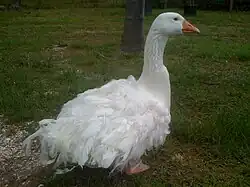Sebastopol goose

The Sebastopol is a breed of domestic goose, descended from the European Greylag goose.[1] First exhibited in England in 1860 under the name 'Sebastopol goose';[2] they were also referred to as Danubian geese, a name first used for the breed in Ireland in 1863.[3] 'Danubian' was used as a synonym in the 19th century; and only given precedence by Edward Brown after the turn of the 19th century.[4] The Sebastopol is a medium-sized goose with long, white curly feathers. The feathers of the neck are smooth and sometimes greyish brown. Crosses have produced all-grey, buff, and saddle back variants.[5][6] Feathers on the breast may be curly (frizzle) or smooth. The gander weighs 12-14 lbs while the goose weighs 10-12 lbs. The legs and shanks are orange and the eyes bright blue. Grey and buff colored Sebastopol have brown eyes. On average, females produce 25-35 eggs per year.[7] Though domesticated breeds of geese generally retain some flight ability, Sebastopols cannot fly well due to the curliness of their feathers and have difficulty getting off the ground.[8][9] They need plenty of water to keep themselves clean, and to clean their sinuses (as do all waterfowl).[10]
In German, they are called Lockengans or Struppgans, meaning "curl-goose" and "unkempt goose".
History
It has been stated the breed was developed in Central Europe along the Danube and the Black Sea.[11][12] However, it is documented that the birds were originally met with in the Crimea and sent from the port of Sevastopol, as the name implies, and arrived in England in 1860.[2][13] By the 19th century they were found in all the countries surrounding the Black Sea. The alternate name Danubian reflected their prevalence around the river Danube.[14] They were originally bred to use their curly feathers in pillows and quilts.[15]
Breeding
Breeding over the last hundred years has increased the average weight of the birds by thirty percent.[16] This occurred in America due to matings with Embden Geese made in the late 19th century.[17]
See also
Gallery
-
 Sebastopol goose and goslings
Sebastopol goose and goslings -
 White gosling
White gosling -
 White and blue goslings
White and blue goslings -
 Rare saddleback color scheme
Rare saddleback color scheme -
 Close up of saddleback back coloring
Close up of saddleback back coloring -
 Two white Sebastopols
Two white Sebastopols
References
- ^ Holderread (1981) p.24
- ^ a b The Field (1860) pp.348-9
- ^ Journal of Horticulture (1863) p.58
- ^ Brown (1906)p.186
- ^ Ashton (1999) p.33
- ^ Holderread (1981) p.38
- ^ Holderread (1981) p.25
- ^ Holderread (1981) p.19
- ^ Luttmann (1978) p.38
- ^ Domestic Waterfowl Club Sebastopol article
- ^ Wright (1885) pp. 570-572
- ^ Tegetmeier and Weir (1867) pp.315-316
- ^ Illustrated London News (1860) p.231
- ^ Ashton (1999) p.32
- ^ Kear and Hulme (2005) pp.6-7
- ^ Ashton (1999) pp.32-33
- ^ Weir (1904) p.1111
- Ashton, Chris (1999) Domestic Geese ISBN 1-86126-271-X
- Brown, Edward (1906) Races of Domestic Poultry Pub. Edward Arnold. London.
- Holderread, Dave (1981) The Book of Geese: a Complete Guide to Raising the Home Flock ISBN 0-931342-02-3
- Journal of Horticulture (1863) 13 January. Pub.London.
- Kear, Janet and Hulme, Mark (2005) Ducks, Geese and Swans ISBN 0-19-854645-9
- Luttmann, Gail and Rick (1978) Ducks & Geese in your Backyard ISBN 0-87857-224-4
- Robinson, John H. (1912) Principles and Practice of Poultry Culture
- Tegetmeier, William Bernhard and Weir, Harrison (1867). The Poultry Book: Comprising the Breeding and Management of Profitable and Ornamental Poultry, their Qualities and Characteristics
- Weir, Harrison; Johnson, W.G.; Brown, G.O. (1904) The Poultry Book. Pub. Doubleday, Page & Co. New York
- Wright, Lewis (1885) Book of Poultry
- Domestic Waterfowl Club Sebastopol article
External links
- Sebastopol Geese on poultrykeeper. British Breed Standard information and photos.